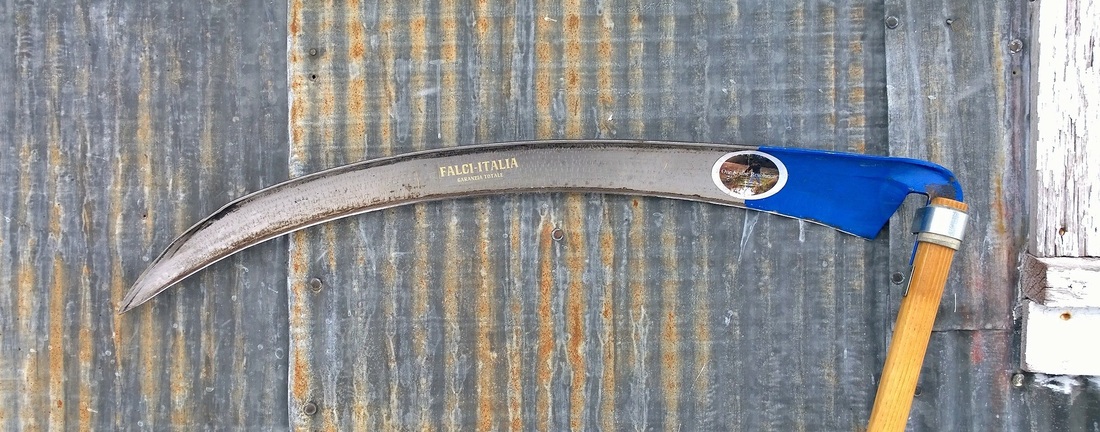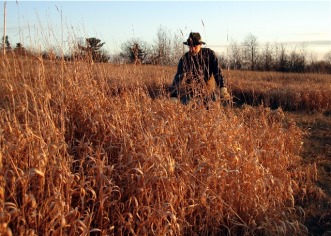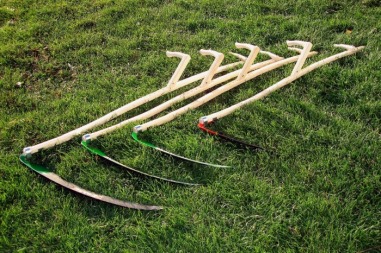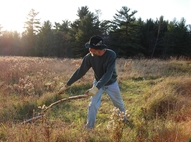|
1SR Falci 100, in "Botan Blue", 85cm, 50mm wide, 603g, This blade has a fully-formed belly and rocker, to handle bumpier fields, like my favorite Penn. Dutch Redtenbacher blade. I asked Falci to reproduce my favorite Redtenbacher blade in 85cm, and they said there was no need to. This one is similar, they said, and will probably mow better! So there you go. This blade is awesome. A strong, stiff, well-formed, and balanced blade. The form of the blade is more like a cross between my Gartensense blades and the FUX 2010 or Profisense. It doesn't have as much of a hook in front, as the 2010, making it easier for beginners to use, and requires less twisting of the torso in the full field stroke, which I prefer. I like using a lot of lateral motion in my scythe stroke. Only double peened, but to a thinly tapered bevel that runs easily over the nail, in the thumbnail test. I finally got to really put it through it's paces this fall, and shoot some video of it in action. See the three videos below:
 The farmers at New Story Farm called me up, and said they needed a scythe asap, to mow some green feed for their beef cows. Their last pasture was exhausted, and their newly seeded pastures weren't ready to withstand being trampled by the herd yet, but could be mowed. Sounded like fun to me, so I personally delivered their scythe, and showed them how to mow and helped them harvest some green feed. http://www.newstoryfarm.com/ Here is a vintage gem, filmed prior to 1950, showing how they mowed and made hay with a scythe in Mittelberg, Austria. It was posted on YouTube by feworieser. (If the music is too overwhelming you can click the volume button and mute it, and watch it as the silent film it was probably made to be.)
It shows what the traditional mowing with an Austrian scythe was like, before mowing with a side-shift. It also shows peening with a tall anvil, honing (Austrian style), and some very impressive technique with spreading the cut vegetation with a hayfork at 2:12. It also shows how they brought the hay to the barn with a garden cart, and bundling the hay with rope for carrying on the back from areas to steep for a cart. Most interestingly to me, at 3:34 and at 5:00, it shows how the traditional Austrian hay drying racks are used. Don't put your scythes away for the season just yet! Now is a great time of year to mow tall dry grasses for use as animal bedding, garden mulch, or dry matter for compost piles. Reed Canary grass is my favorite dry grass. It's easy to mow and yields a tremendous volume of straw. At this time of year, the seeds have all fallen off, and since it's a dominant monoculture, there aren't many other plants mixed in, so it makes a great seed-free mulch. When harvested in dry weather, it requires no further drying, and you can put it directly in a haystack, or pile it high in your barn or chicken coop for winter bedding. The big hollow stems are great for keeping air in a compost pile. So after you use it for bedding, the manure and straw mix is very compostable. It doesn't form a dense anaerobic mass (like hay or leaves do), that takes forever to break down. The video below shows how I mow Reed Canary Grass: This next video shows how we bring the Reed Canary grass straw in from the field. I don't have a real barn here yet, so I store the straw on my Pyramid Haystack frame next to my goose house, and cover it with a tarp. In the winter, it's easy to take off the tarp, and pull off as much straw as I need for bedding at a time for my geese, and then cover the stack back up again. I recently posted this new instructional scythe video on YouTube. The first part of the video shows the cutting action of the blade, and basic mowing form. The second part explains the advanced field mowing form that incorporates an exaggerated side-to-side weight-shift, that turns mowing with a scythe, into quest for perpetual motion. Mowing with a side-shift requires a more closed hafting angle on your scythe blade, than is commonly available. I learned this advanced technique at the 2006 International Scythe Symposium in Canada.
|
Botan AndersonArchives
March 2023
Categories
All
|




 RSS Feed
RSS Feed